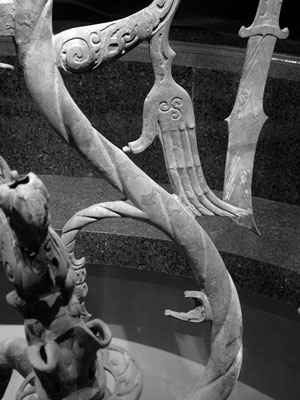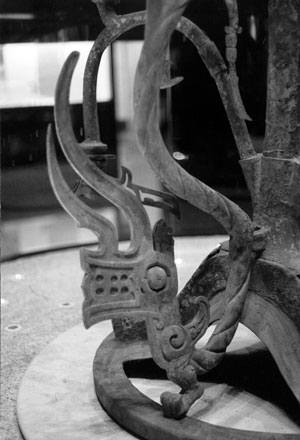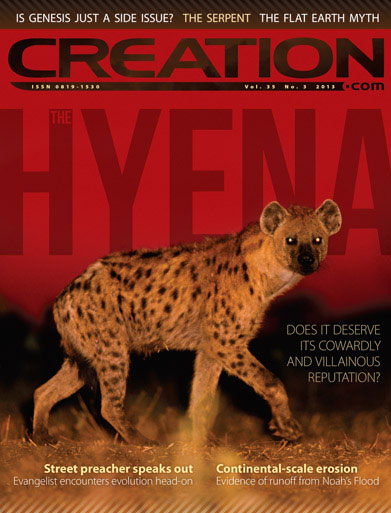The Serpent

Is the account of Eve’s temptation by the serpent meant to be taken literally, or is it purely symbolic? And who or what was the serpent? I was once discussing creation with a church leader, when he asked me sarcastically if I believed there were walking, talking snakes before the Fall. Of course, there was only one serpent (snake) who spoke, according to the biblical account. But the Garden of Eden account is so extraordinary, it is perhaps understandable that many Christians see it as merely symbolic.

However, it is clear, for many compelling reasons, that Genesis 1–11 is meant to be understood as real history.1 Whenever the New Testament refers to the events and characters of early Genesis, there is no suggestion that these represent anything other than history—and that includes the temptation of Eve (2 Corinthians 11:3; 1 Timothy 2:13–14). We need to bear in mind, too, that more than one extraordinary thing happened at the dawn of human history. This was soon after God had created the world and, indeed, time itself. Furthermore, the only world we have any experience of is the fallen world we live in today. So, it is hard to imagine how things were before the Fall.
Since the Garden of Eden story is historical, we would expect many peoples to retain some memory of it, and to carry that memory with them after the dispersion from Babel. (The memory would of course become distorted and corrupted over time, as with the memory of Noah’s Flood.) In fact many ancient peoples, such as the Sumerians2 and Greeks3, did indeed have memories of the Garden of Eden, with the tree of the knowledge of good and evil and the temptation of Eve by the serpent.
One example came to light through an amazing find made near Guanghan, China, in 1986. Many artifacts which were made by the Sanxingdui people some 2,700 to 4,700 years ago (by secular reckoning) were excavated. One of the artifacts was a life-size bronze fruit tree, some 4 metres (13 feet) tall. A bronze snake and human hand were attached to the tree. Various details suggest that this artifact symbolized the temptation of Eve by Satan, and that the snake and the fruit were bringers of death. The snake even had feet!4
The serpent
Bible-believers generally say that it was Satan who deceived Eve, but he possessed and spoke through a serpent. The incident of Balaam’s donkey (Numbers 22:22–35) shows that this could indeed have happened. Another possibility is that Satan revealed himself to Eve in the form of a serpent, rather than speaking through an actual animal. Theological arguments disputing this possibility5seem unconvincing. The experiences of deceptive manifestations described by Gary Bates in Alien Intrusion, for example, suggest that it is a real possibility.6
In the Bible, angels sometimes appeared to humans in physical form, as in Genesis 18:1–19:29. And elsewhere there are many accounts of demons manifesting themselves in physical form. The (non-Christian) paranormal researcher John Keel wrote,

“The Devil and his demons can, according to the literature, manifest themselves in almost any form and can physically imitate anything from angels to horrifying monsters with glowing eyes. Strange objects and entities materialize and dematerialize in these stories, just as the UFOs and their splendid occupants appear and disappear, walk through walls, and perform other supernatural feats. Demonology is not just another crackpot-ology. … Thousands of books have been written on the subject, many of them authored by educated clergymen, scientists and scholars, and uncounted numbers of well-documented demonic events are readily available to every researcher.”7
Genesis 3:1 says that “the serpent was more cunning than any beast of the field which the Lord had made”. This description certainly applies to Satan, but is difficult to apply to any living reptile. The same difficulty is true of the serpent tempting Eve, as well as of the serpent in the Messianic prophecy in verse 15 that a descendant of the woman would ‘bruise the serpent’s head’. The curse in verse 14, however, does seem to apply to the reptile which Satan used to deceive Eve. In a metaphorical sense, though, it could be said to apply to Satan also.
The best interpreter of Scripture is Scripture itself, and Revelation 12:9 helps us in understanding this portion of Genesis:

“So the great dragon was cast out, that serpent of old, called the Devil and Satan, who deceives the whole world; he was cast to the earth, and his angels were cast out with him.”
See also Revelation 20:2 and John 8:44. Note that Satan is called “that serpent of old, who deceives the whole world”. I suggest that in Genesis 3, ‘the serpent’ primarily refers to Satan himself. It is an appropriate title for Satan, since that is the animal through which he chose to speak, or the form which he assumed when he appeared to Eve.
When God pronounced the curse on the serpent (verse 14), animal serpents were included in this curse, not because they were evil in themselves, but as a sign or symbol of the curse on Satan—a perpetual reminder to mankind. Thus the Genesis account of Eve’s temptation is a literal historical reality which incorporates symbolism. In a similar way, God said that the rainbow would be a perpetual reminder or symbol of His promise never again to send a worldwide flood. The rainbow is a symbol, but the rainbow’s appearance to Noah was a real event, and the account of the Flood is real history.8
Because of this association with Satan, serpents also came to symbolize sin and the curse of sin. This is shown by the incident recorded in Numbers 21:4–9, and the words of Jesus recorded in John 3:14–15. The bronze serpent which Moses set up on a pole symbolized the fact that, when Jesus hung on the cross, He became sin for us (2 Corinthians 5:21). It reveals the enormity of the sacrifice which He made in order to save us from the penalty of sin. He Himself bore our sins in his own body on the tree (1 Peter 2:24). He became a curse for us, “For it is written, ‘Cursed is everyone who hangs on a tree’” (Galatians 3:13).

The wording of the curse on the serpent implies that the creature previously had legs, and did not slide along the ground. Regarding this, it is interesting that pythons and boas (probably the one Genesis kind) have a pair of spurs, and evolutionists believe that these are the remains of hind legs. It is conceivable that the kind of serpent which Satan ‘used’ was indeed the ancestor of pythons and boas. Loss of legs is not difficult to explain genetically; it is the acquisition of legs which cannot be explained naturalistically. Nevertheless, the impression one gets from the Bible text is that the change in the serpent’s locomotion was sudden. Hence, it is likely that it was a supernatural event, rather than a progressive change by accumulation of mutations. And in any case, the spurs on pythons/boas function as reproductive claspers, which implies that they are not some left-over remnants, but were designed for this function.9
Not a side issue
The question of whether the Garden of Eden account (including the serpent’s temptation of Eve) is real history or symbolic myth is not a side issue. The Gospel is rooted in historical facts, including:
- God’s original creation really was “very good” before it was spoiled by the entrance of sin.
- Adam and Eve were real people, the ancestors of all people today.
- The Fall really happened (with the entry of both spiritual and physical death).
- The actual death and bodily resurrection of Jesus Christ.
See, for example, 1 Corinthians 15, especially verses 21, 22, 45–47 (also see: ‘Just preach the Gospel!’). The messages here are powerful and authoritative, because they are founded on, and backed up by, solid historical facts.10 The Bible does use symbolism, but it often does so within real history (e.g. the Passover account). We ignore the history at our peril.
References and notes
- Batten, D. and Sarfati, J., 15 Reasons to Take Genesis as History, CMI, Brisbane, 2006. Return to text.
- Johnson, R. Jnr, The serpent worshippers, J. Creation 17(3):66–69, 2003; creation.com/serpent-worshippers. Return to text.
- Johnson, R. Jnr, Athena and Eve, J. Creation 17(3):85–92, 2003; creation.com/Athena-Eve. Return to text.
- Brennecke, S., The Bronze Tree of Sanxingdui: the oldest man-made Genesis artefact?, J. Creation 20(2):8–10, 2006; creation.com/bronze-tree. Return to text.
- Thiessen, H., Lectures in Systematic Theology, Revised edition, Eerdmans. Grand Rapids, 1979, p. 180. Return to text.
- Bates, G., Alien Intrusion, Creation Book Publishers, Powder Springs, GA, 2010. Return to text.
- Keel, J., Operation Trojan Horse, Illuminet Press, Lilburn, 1996, p. 192. Return to text.
- For more information and other lessons we can learn, see creation.com/who-was-the-serpent and creation.com/snake-Eden. Return to text.
- Similarly, the tiny lower ‘limbs’ on the serpentine fossil whale Basilosaurus probably functioned as claspers, and were not vestigial remnants of a time when whales ‘walked on land’. Return to text.
- Gurney, R., History and pseudo-history, Creation 32(3): 36–37, 2010; creation.com/pseudo-history. Return to text.






Readers’ comments
Comments are automatically closed 14 days after publication.